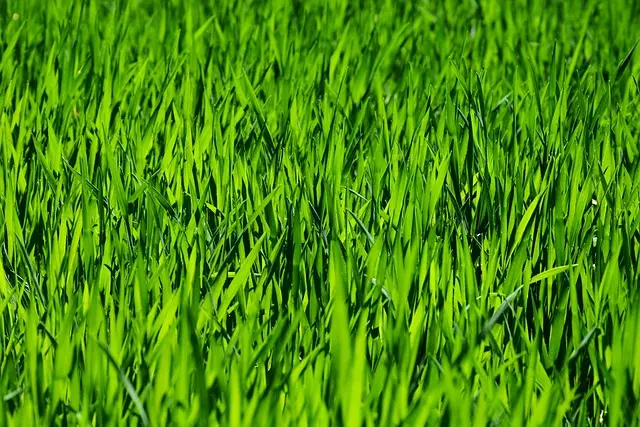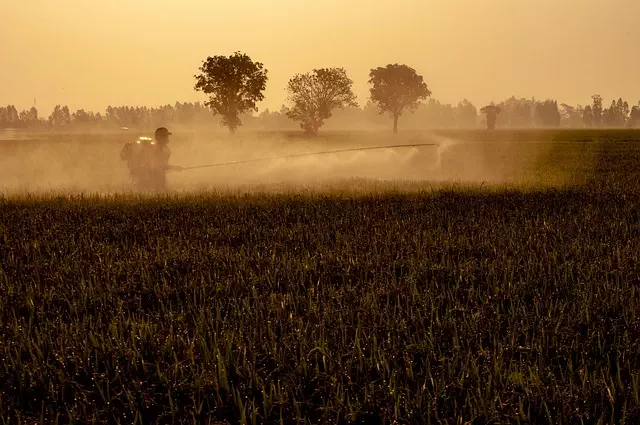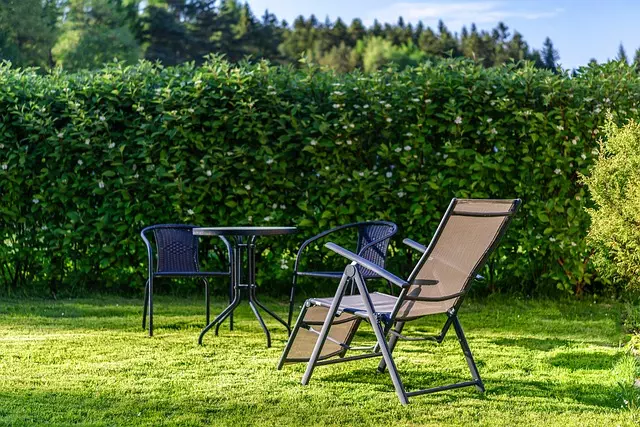Lawn Care and Landscaping significantly enhance curb appeal by creating visually appealing, healthy outdoor spaces. A well-maintained lawn through regular mowing following the one-third rule, selecting hardy grass varieties, and integrating a variety of plants, stone paths, and garden beds with seasonal color, contributes to a property's charm and first impression. The use of native plants promotes local biodiversity and requires less maintenance, while smart irrigation systems ensure water conservation and efficient lawn care. A holistic approach that prioritizes soil health is crucial for plant development, requiring organic matter addition, pH and nutrient testing, and adjustments to foster a sustainable ecosystem. Expert advice tailored to local climatic conditions and soil factors ensures the longevity and beauty of your landscape. Additionally, thoughtfully designed hardscapes like pathways, patios, and water features complement the outdoor space, providing functional and aesthetic value, while maintaining a natural balance. Lawn Care and Landscaping practices that consider both design and sustainability lead to eco-friendly and visually stunning outdoor environments that reflect well on homeowners.
Embarking on an outdoor space design and build project offers a canvas for creativity, sustainability, and personal expression. This comprehensive guide delves into transforming your outdoor environment into a thriving extension of your home. From enhancing curb appeal through strategic lawn care to integrating eco-friendly hardscapes and sustainable practices, each step is crucial in creating an inviting and functional oasis. Discover how to select the right plants for your regional climate and soil types, design outdoor lighting to extend your evenings, and plan for all seasons. Learn about the importance of proper drainage and irrigation systems, as well as tips for organic lawn care to foster a healthy ecosystem. Whether you’re entertaining guests or seeking tranquility in a small space, this article provides valuable insights into xeriscaping, native plant use, landscaping with slopes, and employing low-maintenance plants for a busy lifestyle. Utilize landscape design software to visualize your dream space before construction begins. This article is a treasure trove of information for anyone looking to enhance their outdoor living experience through thoughtful lawn care and innovative landscaping.
- Enhancing Curb Appeal with Strategic Lawn Care Techniques
- The Role of Soil Health in a Vibrant Landscape
- Choosing the Right Plants for Your Regional Climate and Soil Types
- Integrating Hardscapes: Pathways, Patios, and Water Features
Enhancing Curb Appeal with Strategic Lawn Care Techniques

A well-manicured lawn serves as the cornerstone of curb appeal, immediately setting the tone for a home’s surroundings. Strategic lawn care techniques are pivotal in achieving and maintaining this desirable aesthetic. Homeowners looking to enhance their property’s exterior charm can start by implementing a consistent mowing regimen that adheres to the one-third rule, where no more than one-third of the grass height is removed at any single mowing. This practice not only fosters a healthier lawn but also encourages deeper root growth, contributing to a lush and vibrant appearance. Additionally, the selection of appropriate grass varieties tailored to local climate conditions can significantly impact both the resilience and visual appeal of the lawn.
Complementing grass care with landscaping elements such as diverse plantings, decorative stone paths, and well-placed garden beds can further elevate curb appeal. Seasonal color displays with annuals and perennials can introduce pops of color that draw the eye and create a welcoming atmosphere. Moreover, incorporating native plants not only adds to the local ecosystem but also reflects a sense of place and can reduce maintenance over time. Smart irrigation systems, which conserve water while ensuring optimal hydration for the lawn and garden, are another aspect of strategic lawn care that contributes to a beautifully designed outdoor space. Landscaping with a view towards both functionality and aesthetics ensures that a home’s exterior is not only appealing but also sustainable and easy to maintain.
The Role of Soil Health in a Vibrant Landscape

Maintaining a healthy landscape begins with understanding and nurturing soil health, an integral component of any thriving outdoor space. Soil serves as the foundation for plant growth, holding nutrients and water that are crucial for vegetation to flourish. For those seeking to optimize lawn care and landscaping efforts, the quality of the soil cannot be overstated. It is the medium that supports root development, influences plant resilience against pests and diseases, and contributes to the overall ecosystem balance. Enhancing soil health through practices like organic matter addition, proper aeration, and targeted amendments can significantly improve grass and plant vitality, leading to a lush, vibrant lawn that is both aesthetically pleasing and environmentally sustainable. Regular testing of the soil’s pH and nutrient levels ensures that adjustments are made timely to support optimal growth conditions, thereby reducing the need for excessive fertilization or irrigation. In the realm of landscaping, a focus on soil health not only promotes a visually appealing outdoor space but also fosters biodiversity and supports the ecological balance within the environment. Landscapers and homeowners alike benefit from this holistic approach, as healthy soils lead to healthy plants, which in turn create beautiful and sustainable landscapes. Implementing best practices in lawn care and landscaping, with a keen emphasis on soil health, is essential for achieving and maintaining an outdoor space that stands the test of time and enhances the natural beauty of any property.
Choosing the Right Plants for Your Regional Climate and Soil Types

When embarking on outdoor space design, selecting plants that thrive in your local climate and soil conditions is paramount for a flourishing landscape. Understanding your regional climate, including its temperature extremes and precipitation patterns, allows for the choice of plants with similar climate requirements, thereby minimizing maintenance and ensuring year-round vibrancy. For instance, regions with hot, dry summers benefit from xeriscaping with drought-resistant plants, while cooler, moister climates might support a variety of lush greenery and flowering species.
Similarly, soil type plays a significant role in determining the suitability of plants for your outdoor space. Soils vary widely in pH, texture, and nutrient content, influencing a plant’s ability to absorb water and nutrients. A soil test can provide valuable insights into amending your soil to better support your chosen vegetation. Consulting with local lawn care and landscaping professionals can offer tailored advice, ensuring that the plants you select are well-matched with both your climate and soil type. This synergy between plant selection and environmental conditions not only enhances the aesthetic appeal of your outdoor space but also promotes sustainability and reduces the need for frequent, resource-intensive interventions.
Integrating Hardscapes: Pathways, Patios, and Water Features

Outdoor spaces can be transformed into tranquil retreats or vibrant entertainment areas through thoughtful integration of hardscapes such as pathways, patios, and water features. Pathways serve not only as a guiding element within the landscape but also enhance movement and accessibility around the yard. When designing pathways, consider the lawn care maintenance required to ensure they complement the natural greenery rather than compete with it. Patios extend living spaces outdoors, providing a durable and versatile platform for relaxation or social gatherings. Choosing materials that align with the home’s architectural style can create a seamless transition between indoors and out. Water features, ranging from serene ponds to dynamic fountains, add an element of calmness and fascination to any outdoor design. They require careful planning to manage water usage sustainably while providing a soothing soundscape that elevates the ambiance of the garden or yard. Landscaping professionals skilled in lawn care can guide homeowners through the selection of appropriate hardscape elements that not only enhance the aesthetic appeal but also complement the existing landscape and climate conditions, ensuring a harmonious balance between structure and nature.
In conclusion, transforming an outdoor space into a harmonious blend of greenery and hardscapes not only elevates curb appeal but also fosters a healthy environment that can thrive with the right care and attention. By implementing strategic lawn care techniques, homeowners can ensure their gardens make a lasting impression while also understanding the importance of soil health for a vibrant landscape. Careful selection of plants that are native to and well-suited for the local climate and soil types will create a low-maintenance yet visually stunning oasis. Integrating thoughtfully designed hardscapes such as pathways, patios, or water features adds functionality and aesthetic appeal, making your outdoor space an extension of your home’s comfort and style. Lawn Care and Landscaping are integral components in achieving this balance, ultimately enriching the quality of life and property value.


